The Portuguese man o’ war (Physalia physalis), also known as the false jellyfish or bluebottle, is a marine hydrozoan from the phylum Cnidaria. Despite its jellyfish-like appearance, it is not a single organism, but rather a colonial entity made up of highly specialized individual zooids that function together. Its tentacles can reach over 50 meters and are lined with potent stinging cells capable of delivering a painful—and sometimes deadly—sting.
Want to know what the Portuguese man o’ war really is, how to identify it, and what to do if you’re stung? Keep reading to discover everything about this fascinating yet dangerous ocean dweller.
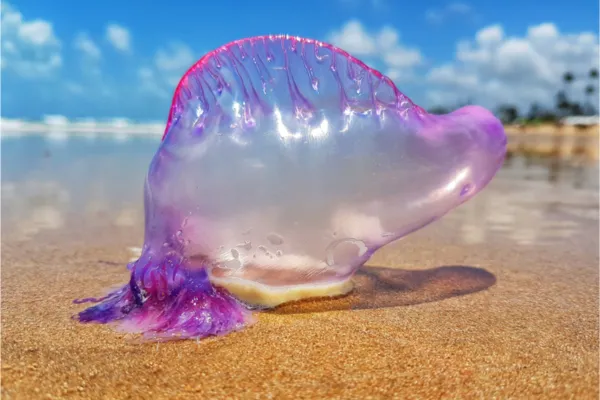
Though often confused with a jellyfish, the Portuguese man o’ war is not a true jellyfish. It belongs to the class Hydrozoa, a subgroup of Cnidarians—a group that includes jellyfish, corals, and sea anemones.
This creature is a floating colonial organism, meaning it's composed of multiple genetically identical individuals (called zooids or polyps) that specialize in different functions such as feeding, reproduction, and defense. Together, they operate as a single unit and drift passively in ocean currents as part of the gelatinous plankton.
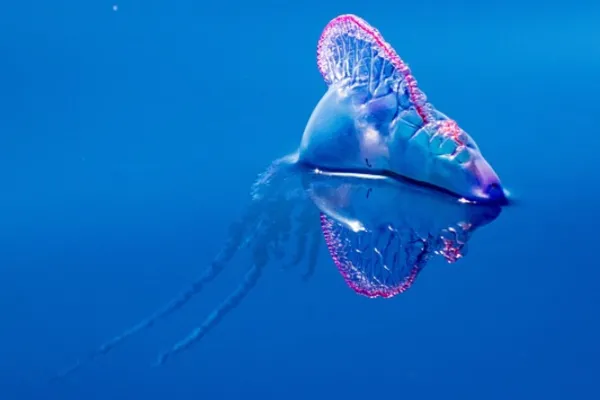
Domain: Eukarya
Kingdom: Animalia
Phylum: Cnidaria
Class: Hydrozoa
Order: Siphonophora
Family: Physaliidae
Genus: Physalia
Species: Physalia physalis
Float (Pneumatophore): The upper part of the organism, called the float, is a gas-filled, sail-like bladder that remains above the water surface. It is usually violet, pink, or blue in color and helps keep the colony buoyant.
Sail-shaped appearance: Its shape resembles a sailing ship, which is where the name “Portuguese man o’ war” comes from.
Tentacles: It has long tentacles (dactylozooids) that can extend up to 50 meters (164 feet). These are packed with nematocysts, the stinging cells used to paralyze prey and defend against predators.
No central brain: Like other Cnidarians, it lacks a brain. Each zooid carries out specific tasks independently.
Feeding structures: The organism has gastrozooids for digestion and a central feeding polyp at its core.
Reproductive structures: Around the feeding polyp are gonozooids, which produce gametes. These reproductive cells sink to the ocean floor, where fertilization takes place, and new polyps are formed that later float back to the surface.
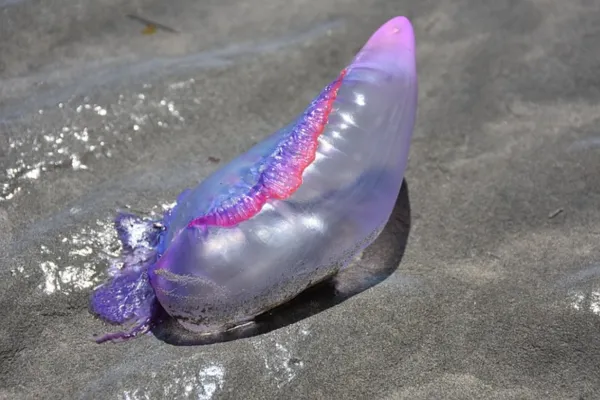
The Portuguese man o’ war is extremely dangerous to humans. Its venomous tentacles contain cnidocytes that deliver powerful toxins capable of causing:
Neurotoxic effects
Cytotoxic effects
Cardiotoxic effects
Even dead specimens washed up on shore can sting, as their stinging cells remain active for hours or days.
Severe, burning pain
Red welts, swelling, and itching
Nausea, vomiting, or fever
Allergic reactions or anaphylactic shock
In extreme cases, death
Important safety note: Never touch a Portuguese man o’ war, whether floating or stranded.
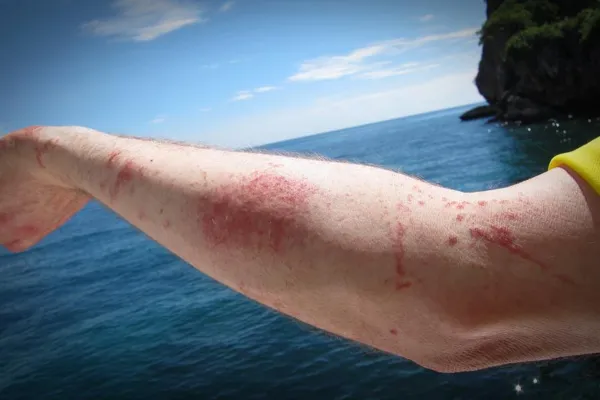
If stung, follow these steps:
Exit the water immediately to avoid further contact.
Rinse the affected area with salt water or alcohol (not freshwater or vinegar) to gently remove any tentacle residue. Do not rub the area.
Use warm seawater if available, as heat can help inactivate toxins.
Seek medical attention immediately. Doctors may prescribe corticosteroid creams to reduce inflammation and pain.
Portuguese man o’ wars are found in warm tropical and subtropical waters, including:
The Atlantic Ocean
Florida Keys and the Gulf of Mexico
The Caribbean Sea
Parts of the Pacific and Indian Oceans
They are frequently observed near coastlines, including Spain’s Canary Islands and the southern Mediterranean coast. They often wash ashore after storms or strong currents.
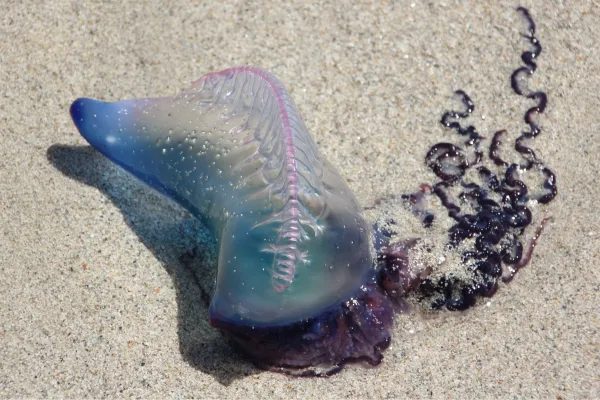
Since they don’t swim, Portuguese man o’ wars drift with the current, waiting for prey to get entangled in their tentacles.
They primarily feed on:
Small fish
Zooplankton
The stinging cells immobilize the prey, which is then drawn up to the feeding polyps for digestion.
The Portuguese man o’ war reproduces through both sexual and asexual means.
Colonies are either male or female.
Reproductive polyps release gametes into the water, where external fertilization occurs.
Fertilized larvae develop into floating colonies.
New polyps “bud” off from mature individuals.
These buds develop into genetically identical organisms and eventually separate to form new colonies.
The Portuguese man o’ war is one of the most fascinating yet feared creatures in the ocean. While its colorful float may seem beautiful from afar, its sting can cause serious harm. Respect the ocean—and this remarkable colonial predator—by keeping your distance.
If you enjoyed this article, feel free to explore more in our Marine Animals or Dangerous Sea Creatures categories.
Bibliography
Editorial staff of National Geographic Spain. (05 October 2019). National Geographic Spain. The false jellyfish: https://www.nationalgeographic.com.es/naturaleza/la-mejor-falsa-medusa_7011
Munro, C., Vue, Z., Behringer, R.R. et al. Morphology and development of the Portuguese man of war, Physalia physalis. Sci Rep 9, 15522 (2019). https://doi.org/10.1038/s41598-019-51842-1 Available en: https://www.nature.com/articles/s41598-019-51842-1
Mark R Stein, John V Marraccini, Neal E Rothschild, Joseph W Burnett. Fatal Portuguese man-o'-war (Physalia physalis) envenomation. Annals of Emergency Medicine, Volume 18, Issue 3, 1989, Pages 312-315, ISSN 0196-0644. https://doi.org/10.1016/S0196-0644(89)80421-4. Available en: https://www.sciencedirect.com/science/article/abs/pii/S0196064489804214
Prieto, L., Macías, D., Peliz, A. et al. Portuguese Man-of-War (Physalia physalis) in the Mediterranean: A permanent invasion or a casual appearance?. Sci Rep 5, 11545 (2015). https://doi.org/10.1038/srep11545 Available en: https://www.nature.com/articles/srep11545
animal tags: Portuguese man-of-war
We created this article in conjunction with AI technology, then made sure it was fact-checked and edited by a Animals Top editor.